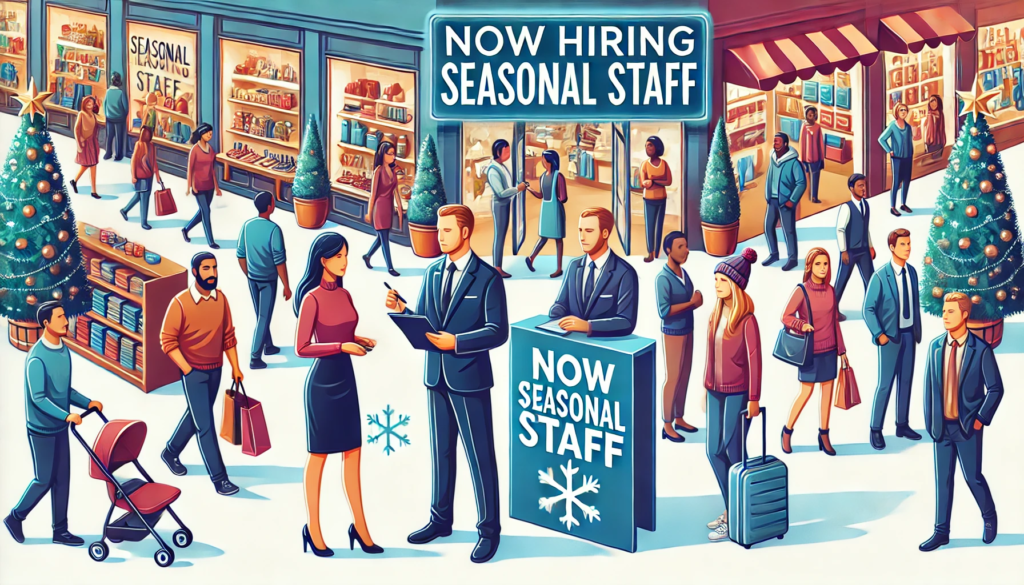Key Takeaways
- Strategic Recruitment: Utilize multiple hiring channels, including job boards, referrals, and staffing agencies, to attract top seasonal talent efficiently.
- Effective Onboarding & Training: Provide structured training programs to ensure seasonal employees quickly adapt and perform at peak productivity.
- Retention & Compliance: Offer incentives, career growth opportunities, and adhere to labor laws to maintain a motivated and legally compliant workforce.
In industries where demand fluctuates throughout the year, hiring seasonal employees becomes a crucial aspect of workforce planning.
Whether it is the holiday shopping rush, the summer tourism boom, or a sudden surge in e-commerce orders, businesses must be prepared to scale their workforce efficiently.
Without a well-structured seasonal staffing strategy, companies risk being overwhelmed by customer demands, experiencing operational inefficiencies, and losing revenue due to insufficient manpower.

Seasonal hiring is particularly vital for sectors such as retail, hospitality, logistics, agriculture, and customer service, where peak periods require a temporary yet reliable workforce.
A well-executed seasonal recruitment strategy ensures that businesses not only maintain high service standards but also enhance customer satisfaction, streamline operations, and optimize labor costs.
However, hiring temporary employees comes with unique challenges, including a competitive job market, time constraints for recruitment, the need for rapid training, and compliance with labor laws.
Without proper planning, companies may struggle with high turnover rates, unproductive staff, and disruptions in workflow.
To navigate these challenges effectively, businesses must adopt strategic approaches to seasonal hiring. This includes leveraging multiple recruitment channels, streamlining the hiring process, offering attractive incentives, and investing in efficient onboarding programs.
Additionally, retaining skilled seasonal employees for future hiring cycles can save time and resources while ensuring a reliable talent pipeline.
By implementing the right staffing strategies, organizations can optimize workforce productivity, reduce hiring risks, and build a seamless operational framework that meets peak season demands.
This comprehensive guide explores the most effective strategies for hiring seasonal employees, from identifying staffing needs and sourcing candidates to training, motivating, and retaining temporary workers.
Whether you are a retailer preparing for the holiday rush, a hospitality business gearing up for the summer season, or an e-commerce company handling increased online orders, these insights will help you navigate the complexities of seasonal staffing and achieve long-term success.
Before we venture further into this article, we would like to share who we are and what we do.
About 9cv9
9cv9 is a business tech startup based in Singapore and Asia, with a strong presence all over the world.
With over nine years of startup and business experience, and being highly involved in connecting with thousands of companies and startups, the 9cv9 team has listed some important learning points in this overview of Hiring Seasonal Employees: Effective Strategies for Peak Season Staffing.
If your company needs recruitment and headhunting services to hire top-quality employees, you can use 9cv9 headhunting and recruitment services to hire top talents and candidates. Find out more here, or send over an email to [email protected].
Or just post 1 free job posting here at 9cv9 Hiring Portal in under 10 minutes.
Hiring Seasonal Employees: Effective Strategies for Peak Season Staffing
- Understanding Seasonal Hiring Needs
- Effective Recruitment Strategies for Seasonal Employees
- Training and Onboarding Seasonal Staff
- Retaining and Motivating Seasonal Employees
- Managing Compliance and Legal Considerations
1. Understanding Seasonal Hiring Needs
Hiring seasonal employees requires a strategic approach to workforce planning. Businesses must anticipate demand fluctuations, determine the right number of temporary workers, and allocate resources effectively to ensure smooth operations during peak periods. Understanding seasonal hiring needs involves analyzing past data, identifying peak demand times, and assessing workforce gaps to optimize productivity.
Identifying Peak Demand Periods
Recognizing when seasonal hiring is necessary is the first step in planning an effective recruitment strategy. Different industries experience peak seasons at varying times, and businesses must prepare in advance to meet these demands.
- Retail Industry:
- Peak hiring occurs during major shopping seasons such as Black Friday, Cyber Monday, and the Christmas holiday rush.
- Back-to-school and summer sales also drive seasonal employment needs.
- Example: Large retailers like Walmart and Target hire thousands of temporary workers to handle increased foot traffic and online orders.
- Hospitality and Tourism:
- Hotels, resorts, and restaurants see higher demand during summer, winter vacations, and major holidays.
- Seasonal tourist attractions, such as ski resorts in winter and beach destinations in summer, require additional staff.
- Example: Theme parks like Disneyland and Universal Studios ramp up hiring during school holidays and summer months.
- E-commerce and Logistics:
- Online shopping surges during holiday seasons, requiring more warehouse workers, delivery drivers, and customer service representatives.
- Companies like Amazon and FedEx employ thousands of temporary workers during peak shopping periods.
- Agriculture and Farming:
- Seasonal peaks depend on crop harvesting schedules, requiring a high volume of temporary agricultural workers.
- Example: Vineyards and fruit farms in California and Australia hire workers for grape and citrus harvesting.
- Events and Entertainment:
- Large-scale events, concerts, and festivals need temporary staff for crowd management, ticketing, and hospitality services.
- Example: The Olympics and major sporting events create a surge in demand for temporary event staff.
Determining the Right Number of Seasonal Employees
Hiring too many seasonal employees can increase labor costs, while hiring too few can lead to operational inefficiencies and customer dissatisfaction. Businesses must carefully assess workforce requirements based on demand forecasts.
- Analyzing Historical Data:
- Reviewing past sales reports, customer traffic, and workforce productivity during previous peak seasons.
- Using point-of-sale (POS) data, website traffic analytics, and customer service inquiries to predict staffing needs.
- Forecasting Demand Trends:
- Considering external factors such as economic conditions, industry trends, and market demand.
- Assessing changes in consumer behavior, such as the rise of online shopping impacting in-store foot traffic.
- Evaluating Workload and Shift Coverage:
- Identifying key roles that require additional staffing, such as cashiers, warehouse staff, customer service representatives, and delivery drivers.
- Allocating shifts to cover peak hours, weekends, and holidays when customer activity is highest.
- Flexibility in Workforce Planning:
- Offering part-time and flexible shifts to meet fluctuating demands.
- Implementing an on-call workforce to handle unexpected surges in customer volume.
Balancing Workforce Efficiency and Cost Management
A successful seasonal hiring strategy ensures that businesses maximize workforce efficiency while managing labor costs effectively.
- Preventing Overstaffing:
- Hiring too many employees can lead to unnecessary payroll expenses and reduced profitability.
- Businesses must optimize staff scheduling and cross-train employees to handle multiple tasks.
- Avoiding Understaffing:
- Insufficient staff can result in long customer wait times, lower service quality, and operational bottlenecks.
- High workloads for existing employees may lead to burnout and decreased productivity.
- Utilizing Temporary and Gig Workers:
- Partnering with staffing agencies or using gig platforms to quickly fill short-term job openings.
- Example: Uber Eats and DoorDash scale their delivery workforce during peak holiday seasons by onboarding more gig workers.
Conclusion
Understanding seasonal hiring needs is essential for businesses to plan and execute a seamless recruitment strategy. By identifying peak demand periods, accurately assessing workforce requirements, and balancing efficiency with cost management, companies can ensure they are fully prepared for high-demand seasons. Implementing data-driven hiring strategies and flexible workforce planning can enhance operational performance, improve customer satisfaction, and maximize revenue during peak business periods.
2. Effective Recruitment Strategies for Seasonal Employees
Hiring seasonal employees requires a well-structured recruitment strategy to attract, assess, and onboard the right talent efficiently. Given the temporary nature of these roles, businesses must streamline the hiring process while ensuring they recruit skilled and reliable workers. The competition for seasonal talent can be high, especially during peak hiring periods, making it essential to implement effective recruitment strategies.
Leveraging Multiple Recruitment Channels
Using diverse hiring channels increases the chances of attracting a larger pool of qualified seasonal candidates.
- Job Boards and Online Platforms:
- Posting job openings on leading job sites such as Indeed, Glassdoor, and LinkedIn.
- Using niche platforms like Snagajob and CoolWorks, which specialize in seasonal and hourly employment.
- Example: Retail giants like Macy’s and Best Buy post thousands of seasonal job listings online before the holiday rush.
- Social Media Recruitment:
- Promoting job opportunities on company social media pages (Facebook, Instagram, and Twitter).
- Running targeted job ads on Facebook and LinkedIn to reach potential candidates.
- Example: Starbucks uses Instagram stories to attract seasonal baristas for holiday-themed beverage launches.
- Employee Referral Programs:
- Encouraging current employees to refer friends and family members for seasonal roles.
- Offering referral bonuses or incentives for successful hires.
- Example: Amazon provides referral bonuses to warehouse workers who recommend seasonal hires.
- College and University Partnerships:
- Recruiting students for part-time seasonal roles through campus job fairs and internship programs.
- Posting jobs on university career portals to attract young talent looking for temporary employment.
- Example: Theme parks like Six Flags partner with colleges to hire students for summer jobs.
- Temporary Staffing Agencies:
- Working with recruitment agencies that specialize in short-term staffing solutions.
- Example: Logistics companies like UPS and FedEx partner with staffing agencies to meet seasonal delivery demands.
Optimizing the Hiring Process for Speed and Efficiency
Since seasonal hiring often involves large volumes of candidates, businesses must streamline their recruitment process to minimize delays.
- Using Applicant Tracking Systems (ATS):
- Automating resume screening and shortlisting to speed up hiring decisions.
- Example: Large retailers use ATS software to quickly filter applications and identify top seasonal candidates.
- Conducting Virtual Interviews and Assessments:
- Using video interviews to evaluate candidates quickly, especially for remote seasonal roles.
- Implementing online skills assessments to gauge job readiness.
- Simplified Application Process:
- Reducing lengthy application forms and paperwork to encourage more candidates to apply.
- Offering mobile-friendly job applications to attract a wider talent pool.
Offering Competitive Compensation and Benefits
Attracting seasonal workers requires competitive pay and incentives to stand out in a crowded job market.
- Competitive Hourly Wages:
- Offering wages that match or exceed industry standards to attract quality candidates.
- Example: Target and Amazon raise hourly wages during peak seasons to compete for top talent.
- Seasonal Bonuses and Incentives:
- Providing performance-based bonuses to encourage productivity.
- Offering shift differentials for working on weekends, nights, or holidays.
- Example: Walmart offers additional bonuses for employees who work through the entire holiday season.
- Perks and Discounts:
- Providing employee discounts on products and services as an added benefit.
- Example: Retail stores like Macy’s and Best Buy offer seasonal employees exclusive in-store discounts.
- Flexible Work Schedules:
- Allowing part-time and flexible shifts to accommodate students, gig workers, and second-job seekers.
Building a Strong Employer Brand for Seasonal Hiring
A positive employer reputation can help attract top seasonal candidates and encourage them to return for future peak seasons.
- Highlighting Company Culture:
- Showcasing a fun and engaging work environment through social media and employee testimonials.
- Example: Companies like REI and Patagonia emphasize their inclusive and dynamic work culture to attract seasonal workers.
- Creating a Positive Candidate Experience:
- Providing clear communication about job expectations, schedules, and benefits.
- Ensuring a smooth and professional hiring process to maintain a good employer reputation.
- Encouraging Repeat Seasonal Employment:
- Keeping a database of past seasonal employees and reaching out to them for future opportunities.
- Example: UPS prioritizes rehiring previous seasonal drivers and package handlers.
Conclusion
Effective recruitment strategies for seasonal employees involve leveraging multiple hiring channels, streamlining the hiring process, offering competitive compensation, and building a strong employer brand. By implementing these strategies, businesses can attract skilled seasonal workers, improve retention rates, and ensure operational success during peak seasons.
3. Training and Onboarding Seasonal Staff
Proper training and onboarding are essential for maximizing the productivity and efficiency of seasonal employees. Given the temporary nature of their roles, businesses must streamline these processes to ensure that new hires quickly adapt to their responsibilities and contribute effectively during peak seasons. A well-structured onboarding program not only enhances performance but also reduces turnover and fosters a positive work environment.
Developing a Structured Onboarding Program
A comprehensive onboarding program sets the foundation for a successful seasonal workforce by familiarizing employees with company policies, expectations, and workflows.
- Pre-Employment Preparation:
- Sending welcome emails with job details, schedules, and company policies before the first workday.
- Providing digital onboarding materials, such as training videos and employee handbooks, to accelerate learning.
- Example: Retail chains like Target send new seasonal hires video tutorials on customer service protocols before their first shift.
- Orientation Sessions:
- Conducting a company-wide orientation to introduce seasonal employees to the organization’s mission, values, and culture.
- Assigning mentors or buddies from the permanent workforce to help seasonal hires navigate their roles.
- Example: Amazon hosts large-scale orientation sessions for thousands of seasonal warehouse workers before the holiday rush.
- Clarifying Job Expectations and Responsibilities:
- Providing clear job descriptions to avoid confusion and misalignment with expectations.
- Outlining performance goals and key metrics to measure success in seasonal roles.
- Example: Restaurants like Starbucks train seasonal baristas on service speed expectations to maintain customer satisfaction during peak hours.
Providing Effective Job-Specific Training
Since seasonal employees have limited time to learn on the job, businesses must implement concise yet effective training programs tailored to their specific roles.
- Hands-On Training:
- Using shadowing programs where new hires observe experienced employees before taking on tasks independently.
- Example: Retail brands like Macy’s implement a “train-as-you-go” model where new hires assist senior associates before handling customers alone.
- E-Learning and Digital Training Modules:
- Providing online training resources to allow seasonal employees to learn at their own pace.
- Using gamified training platforms to make learning engaging and efficient.
- Example: Walmart uses interactive e-learning modules to train seasonal associates on cash register operations and inventory management.
- Cross-Training for Flexibility:
- Teaching seasonal employees multiple tasks to improve workforce flexibility.
- Example: Hotels and resorts train seasonal staff in both housekeeping and front-desk duties to adapt to fluctuating guest demands.
Enhancing Customer Service and Soft Skills
Since many seasonal roles involve customer interactions, businesses must train employees on essential soft skills to enhance customer experience.
- Customer Interaction Training:
- Educating seasonal workers on how to handle customer inquiries, complaints, and returns professionally.
- Providing role-playing exercises to practice real-world customer service scenarios.
- Example: Retailers like Best Buy train seasonal sales associates to upsell products while ensuring a positive customer experience.
- Time Management and Efficiency:
- Teaching employees how to manage workloads efficiently, especially in high-demand environments.
- Implementing quick problem-solving techniques to minimize service delays.
- Example: Fast-food chains like McDonald’s provide training on multitasking to ensure quick service during peak hours.
- Workplace Etiquette and Teamwork:
- Encouraging teamwork through group exercises and collaborative assignments.
- Promoting workplace professionalism, including punctuality and appropriate communication.
- Example: Holiday event venues train seasonal staff to work as cohesive teams to manage large crowds effectively.
Ensuring Workplace Safety and Compliance
Safety training is crucial, particularly in industries where seasonal employees work in physically demanding or high-risk environments.
- Occupational Safety Training:
- Educating seasonal workers on workplace hazards, emergency protocols, and safety procedures.
- Conducting drills and simulations for fire safety, equipment handling, and emergency evacuations.
- Example: Warehouses like FedEx and UPS require all seasonal workers to complete forklift and heavy-lifting safety training.
- Compliance with Labor Laws:
- Informing seasonal employees about their rights, work hours, and overtime policies.
- Providing clear guidelines on workplace harassment and discrimination policies.
- Example: Amusement parks like Disney provide mandatory compliance training on guest safety and labor regulations for seasonal workers.
Encouraging Engagement and Retention
Although seasonal workers may only be employed for a short period, fostering engagement can lead to improved performance and encourage them to return for future peak seasons.
- Recognizing and Rewarding Performance:
- Offering incentives for exceptional performance, such as bonuses, gift cards, or recognition programs.
- Example: Retailers like Kohl’s provide seasonal employee performance rewards to boost morale and motivation.
- Providing Career Growth Opportunities:
- Identifying high-performing seasonal workers for permanent employment opportunities.
- Example: Amazon offers full-time job conversions to top-performing seasonal warehouse employees.
- Conducting Exit Interviews for Feedback:
- Gathering insights from seasonal employees about their work experience to improve future training programs.
- Example: Companies like UPS use exit surveys to refine their seasonal onboarding process for the next hiring cycle.
Conclusion
A well-structured training and onboarding process ensures that seasonal employees can quickly adapt to their roles and contribute effectively. By implementing clear orientation programs, job-specific training, customer service development, and workplace safety initiatives, businesses can maximize the productivity of their temporary workforce. Additionally, fostering engagement and providing career growth opportunities can help retain top seasonal talent for future hiring needs.
4. Retaining and Motivating Seasonal Employees
Retaining and motivating seasonal employees is crucial for businesses that rely on temporary workers during peak seasons. High turnover rates among seasonal staff can lead to disruptions in operations, increased hiring costs, and inconsistent service quality. By implementing effective retention and motivation strategies, businesses can not only improve productivity but also build a reliable talent pool for future hiring needs.
Creating a Positive Work Environment
A supportive and engaging workplace encourages seasonal employees to stay throughout their contract and return for future opportunities.
- Fostering a Welcoming Culture:
- Providing a thorough orientation to make seasonal employees feel like part of the team.
- Encouraging full-time staff to assist seasonal hires in integrating into the work environment.
- Example: Retailers like Target assign mentors to seasonal employees to help them adapt quickly.
- Encouraging Open Communication:
- Establishing clear communication channels for seasonal staff to voice concerns and ask questions.
- Holding regular check-ins with managers or supervisors to ensure employees feel supported.
- Example: Hotels and resorts with seasonal employees conduct daily huddles to address concerns and provide feedback.
- Providing Comfortable Work Conditions:
- Ensuring seasonal workers have access to proper break areas, necessary equipment, and safety measures.
- Allowing flexibility in scheduling to accommodate personal commitments.
- Example: Ski resorts offer free or discounted meals to seasonal employees as part of their work benefits.
Offering Competitive Compensation and Incentives
Fair wages and attractive incentives can significantly enhance motivation and job satisfaction.
- Providing Competitive Pay Rates:
- Ensuring wages align with industry standards and are competitive enough to attract quality talent.
- Offering overtime pay during peak demand periods to reward extra effort.
- Example: Retailers like Walmart offer seasonal employees higher hourly rates during the holiday rush to retain staff.
- Introducing Performance-Based Incentives:
- Implementing bonus programs for meeting or exceeding performance targets.
- Rewarding employees with gift cards, discounts, or additional perks for outstanding work.
- Example: UPS provides financial bonuses to seasonal workers who meet productivity goals during peak shipping seasons.
- Providing End-of-Season Bonuses:
- Offering a completion bonus for employees who fulfill their entire seasonal contract.
- Encouraging retention by giving rehire priority to those who stay for the full season.
- Example: Amusement parks like Disneyland provide seasonal employees with a lump-sum bonus for completing their contracts.
Recognizing and Appreciating Employees
Acknowledging employees’ contributions fosters loyalty and encourages them to return for future seasonal work.
- Public Recognition Programs:
- Highlighting top-performing seasonal employees in company meetings or newsletters.
- Featuring employee success stories on internal platforms or social media.
- Example: Amazon acknowledges high-performing seasonal workers through employee-of-the-month programs.
- Celebrating Milestones and Achievements:
- Organizing appreciation events or team lunches to celebrate the season’s success.
- Recognizing employees who have worked multiple peak seasons with the company.
- Example: Retail chains like Kohl’s host end-of-season appreciation events for seasonal staff.
- Providing Personalized Appreciation:
- Sending thank-you notes or small gifts to employees as a token of appreciation.
- Encouraging managers to express gratitude in person to boost morale.
- Example: Local businesses often provide handwritten appreciation letters to seasonal employees as a personal touch.
Providing Career Growth and Development Opportunities
Even if seasonal roles are temporary, offering development opportunities can motivate employees to perform better and return in future seasons.
- Offering Skills Development Programs:
- Providing training in transferable skills such as customer service, sales, or technical skills.
- Allowing seasonal employees to participate in professional development workshops.
- Example: Starbucks offers seasonal baristas access to online training modules to enhance their skills.
- Identifying Top Talent for Future Employment:
- Keeping records of high-performing seasonal employees for potential full-time or repeat seasonal positions.
- Providing letters of recommendation or references for exceptional workers.
- Example: Retailers like Best Buy offer permanent job opportunities to top-performing seasonal staff.
- Encouraging Internal Career Growth:
- Informing seasonal employees about long-term career paths within the company.
- Allowing them to apply for internal positions before opening recruitment to external candidates.
- Example: Theme parks like Six Flags promote seasonal workers to leadership roles based on performance.
Maintaining Engagement Through Team Building
Team-building activities can strengthen relationships among seasonal employees and increase workplace morale.
- Organizing Social Events:
- Hosting team outings, holiday parties, or friendly competitions to encourage bonding.
- Allowing seasonal employees to participate in company-wide activities.
- Example: Retailers like Macy’s host team-building games to keep seasonal employees engaged during high-demand periods.
- Encouraging Collaboration and Peer Support:
- Assigning team projects that require cooperation among seasonal and full-time staff.
- Implementing peer mentorship programs where experienced seasonal employees guide new hires.
- Example: Large warehouses pair new seasonal workers with experienced team members to foster collaboration.
- Creating an Inclusive Work Environment:
- Encouraging respect and diversity in the workplace to make all employees feel valued.
- Addressing workplace conflicts swiftly to maintain a positive atmosphere.
- Example: Hospitality businesses train managers to be inclusive and recognize contributions from all seasonal staff.
Providing Meaningful Work and Purpose
Employees who feel that their work is meaningful are more likely to stay motivated and engaged.
- Highlighting the Impact of Their Roles:
- Helping seasonal workers understand how their work contributes to overall business success.
- Showing appreciation by sharing positive customer feedback and success stories.
- Example: Customer-centric companies like Nordstrom emphasize how seasonal employees enhance customer experiences.
- Giving Employees Autonomy and Responsibility:
- Allowing employees to take initiative in their roles rather than micromanaging.
- Providing opportunities for seasonal staff to suggest improvements or ideas.
- Example: Seasonal retail employees at Apple are encouraged to provide personalized product recommendations to customers.
- Encouraging Passion for the Industry:
- Providing educational resources about the industry to spark long-term interest.
- Offering exposure to different aspects of the business to broaden career perspectives.
- Example: Seasonal ski instructors are given access to advanced training programs to deepen their expertise in sports instruction.
Conclusion
Retaining and motivating seasonal employees requires a strategic approach that prioritizes employee engagement, recognition, and professional development. By fostering a positive work environment, offering competitive compensation, and providing meaningful work experiences, businesses can encourage seasonal staff to stay for the duration of their contract and return for future peak seasons. Through consistent appreciation, career growth opportunities, and team-building efforts, companies can build a loyal and reliable seasonal workforce, ensuring smooth operations year after year.
5. Managing Compliance and Legal Considerations
Hiring seasonal employees involves various legal and compliance obligations that businesses must follow to avoid penalties and ensure fair labor practices. Misclassification, wage disputes, and lack of proper documentation can lead to legal liabilities, fines, and reputational damage. Understanding and adhering to employment laws, tax regulations, and workplace policies can help businesses maintain compliance while creating a secure and ethical working environment for seasonal employees.
Understanding Employment Classification
Proper classification of seasonal employees ensures compliance with labor laws and prevents misclassification penalties.
- Defining Seasonal Employment:
- Seasonal employees are typically hired for a specific period to meet temporary demand surges.
- Unlike full-time employees, seasonal workers may not always receive the same benefits, depending on local labor laws.
- Example: Retailers hiring temporary staff for the holiday season must classify them correctly under labor laws.
- Differentiating Between Employees and Independent Contractors:
- Employees work under company supervision, follow set schedules, and are subject to payroll tax deductions.
- Independent contractors manage their schedules, use their own tools, and are responsible for their taxes.
- Misclassifying an employee as an independent contractor can result in legal fines and back taxes.
- Example: A logistics company hiring seasonal delivery drivers must determine whether they are employees or independent contractors based on their level of control over the work.
- Complying with the Fair Labor Standards Act (FLSA) (U.S.):
- Seasonal employees must receive at least minimum wage as mandated by federal and state laws.
- Overtime pay must be provided if the employee exceeds the standard working hours.
- Example: Amusement parks hiring seasonal workers must ensure compliance with overtime regulations when employees exceed 40-hour workweeks.
Ensuring Proper Hiring Documentation
Employers must complete and maintain accurate hiring records for seasonal employees to meet legal requirements.
- Employment Contracts and Offer Letters:
- Clearly outline job roles, responsibilities, contract duration, and compensation details.
- Specify work hours, termination clauses, and any applicable benefits.
- Example: A ski resort hiring seasonal instructors provides detailed contracts specifying working periods and salary structures.
- Work Authorization and Right-to-Work Compliance:
- Verify employee eligibility to work in the country by completing necessary legal documentation.
- In the U.S., employers must complete Form I-9 to verify work authorization.
- In the UK, businesses must conduct a Right to Work Check before hiring seasonal staff.
- Example: Farms hiring seasonal agricultural workers in the U.S. must comply with the H-2A visa program regulations.
- Background Checks and Reference Verification:
- Conduct necessary background screening based on job requirements, especially for roles involving financial transactions or childcare.
- Check references to validate an applicant’s previous employment and work ethic.
- Example: Camps hiring seasonal counselors conduct background checks to ensure child safety compliance.
Adhering to Wage and Hour Laws
Ensuring seasonal employees receive fair compensation and benefits is essential for compliance.
- Meeting Minimum Wage Requirements:
- Employers must comply with federal, state, or local minimum wage laws.
- If different wage laws apply, businesses must follow the highest wage rate required.
- Example: Retail businesses in California must pay seasonal employees according to the state’s higher minimum wage, even if the federal wage is lower.
- Complying with Overtime Regulations:
- Seasonal employees are entitled to overtime pay based on local labor laws.
- In the U.S., the FLSA mandates 1.5 times the regular pay rate for hours exceeding 40 per week.
- Example: Warehouse workers hired for peak e-commerce seasons must receive overtime pay for extra shifts.
- Managing Payroll Taxes and Withholdings:
- Employers must deduct appropriate payroll taxes from seasonal employees’ wages.
- Seasonal workers may still be subject to Social Security, Medicare, and unemployment taxes based on regulations.
- Example: A company hiring seasonal call center agents must ensure payroll taxes are correctly calculated and reported.
Providing Workplace Safety and Compliance Training
Employers must ensure seasonal workers understand workplace safety policies and legal protections.
- Complying with Occupational Safety and Health Regulations:
- Businesses must provide a safe work environment and comply with occupational safety laws.
- In the U.S., the Occupational Safety and Health Administration (OSHA) outlines employer responsibilities for workplace safety.
- Example: Construction companies hiring seasonal workers must provide safety gear and training to meet OSHA standards.
- Conducting Workplace Harassment and Discrimination Training:
- Seasonal employees should receive training on anti-harassment policies and workplace conduct.
- Employers must ensure a zero-tolerance policy for discrimination or harassment.
- Example: Hospitality businesses hiring temporary waitstaff must conduct training on respectful workplace behavior.
- Ensuring Compliance with Child Labor Laws:
- Employers hiring minors must follow child labor laws regarding working hours and permitted job duties.
- Restrictions vary based on age and industry, with stricter regulations for hazardous work.
- Example: Fast-food chains hiring teenagers must comply with labor restrictions on work hours during school terms.
Managing Employee Benefits and Termination Policies
Employers must clarify seasonal employees’ access to benefits and ensure legal termination practices.
- Determining Eligibility for Employee Benefits:
- Some jurisdictions require seasonal workers to receive certain benefits based on work hours.
- Employers must communicate whether health insurance, paid time off, or retirement contributions apply.
- Example: Large retailers may offer seasonal employees limited benefits if they work over a specific hourly threshold.
- Handling Termination and End-of-Season Procedures:
- Seasonal contracts should clearly define the employment end date and any rehire possibilities.
- Employers must comply with termination notification laws if required by jurisdiction.
- Example: A landscaping company hiring temporary workers outlines termination policies in employee agreements to avoid legal disputes.
- Providing Unemployment Benefits Information:
- Some seasonal employees may qualify for unemployment benefits depending on local laws.
- Employers must provide necessary documents if seasonal staff file unemployment claims.
- Example: Ski resorts inform laid-off seasonal employees about their eligibility for unemployment compensation.
Complying with Industry-Specific Regulations
Certain industries have additional legal requirements for hiring seasonal employees.
- Hospitality and Tourism Compliance:
- Hotels, resorts, and amusement parks hiring seasonal staff must follow local employment laws.
- Employers must provide fair wages, workplace safety training, and visa sponsorship for foreign workers if applicable.
- Example: Cruise ships hiring seasonal entertainers must comply with international maritime labor laws.
- Retail Industry Compliance:
- Retailers must follow laws regarding employee scheduling, break periods, and overtime compensation.
- Some states require advance scheduling notices to prevent unpredictable work shifts.
- Example: New York’s Fair Workweek Law requires retailers to give predictable schedules to seasonal workers.
- Agricultural Labor Compliance:
- Farms hiring temporary agricultural workers must comply with the H-2A visa program or local seasonal labor laws.
- Employers must provide housing, transportation, and fair wages for foreign seasonal workers.
- Example: U.S. farms hiring seasonal fruit pickers must adhere to the Department of Labor’s agricultural worker protections.
Conclusion
Managing compliance and legal considerations for seasonal employees is a critical responsibility for businesses across industries. Proper employment classification, adherence to wage laws, workplace safety regulations, and industry-specific requirements help prevent legal risks and enhance the overall work experience for seasonal staff. By implementing structured compliance strategies, businesses can successfully manage seasonal hiring while maintaining ethical labor practices and avoiding potential legal pitfalls.
Conclusion
Successfully hiring seasonal employees requires a well-structured, strategic approach that ensures businesses meet peak season demands while maintaining operational efficiency. As industries such as retail, hospitality, logistics, and agriculture experience fluctuating workforce needs throughout the year, a proactive seasonal hiring strategy can help organizations attract, train, and retain top talent.
From crafting a compelling job description to utilizing diverse recruitment channels, businesses must adopt innovative hiring practices to secure skilled seasonal workers. Leveraging technology, such as applicant tracking systems and AI-driven recruitment tools, streamlines the hiring process and enables employers to identify the best candidates efficiently. Additionally, offering competitive compensation, flexible work schedules, and attractive benefits can set companies apart in a competitive labor market, ensuring they attract high-quality seasonal talent.
Beyond recruitment, the onboarding and training process plays a vital role in preparing seasonal employees for success. A well-structured onboarding program ensures that new hires quickly adapt to their roles, understand company policies, and provide excellent customer service. Comprehensive training, including hands-on learning experiences, mentorship programs, and digital resources, enhances productivity and minimizes the learning curve. Providing seasonal employees with adequate support and resources fosters a positive work environment, improving job satisfaction and reducing turnover rates during peak periods.
Retaining and motivating seasonal employees is equally important for maintaining workforce stability and maximizing productivity. Employers can achieve this by creating an engaging work culture, recognizing employee contributions, and offering performance-based incentives. Career advancement opportunities, such as pathways to permanent roles, also encourage seasonal employees to remain dedicated and perform at their best. Establishing strong relationships with high-performing seasonal workers can also benefit future hiring efforts, as experienced employees may return for subsequent peak seasons.
Managing compliance and legal considerations is another critical aspect of seasonal hiring. Employers must ensure proper classification of seasonal workers, adhere to wage and hour regulations, and comply with industry-specific labor laws. Accurate record-keeping, proper documentation, and adherence to workplace safety regulations mitigate legal risks and protect both employers and employees. Organizations must also stay informed about changes in labor laws to ensure continuous compliance with employment regulations.
To optimize seasonal hiring efforts, businesses should continuously evaluate and refine their strategies. Conducting post-season assessments, gathering employee feedback, and analyzing performance data help identify strengths and areas for improvement. Leveraging insights from past hiring cycles allows companies to refine their recruitment, onboarding, and retention strategies for future peak seasons. Additionally, maintaining a database of past seasonal employees facilitates faster rehiring of experienced workers, reducing hiring and training costs.
In conclusion, hiring seasonal employees is a complex but essential process for businesses experiencing fluctuating workforce demands. By implementing effective recruitment strategies, providing thorough training and onboarding, fostering employee engagement, ensuring legal compliance, and refining hiring processes, businesses can build a reliable seasonal workforce. A well-executed seasonal hiring strategy not only supports business continuity during peak periods but also enhances customer satisfaction, operational efficiency, and long-term workforce stability. Organizations that invest in optimizing their seasonal hiring practices will gain a competitive advantage, ensuring seamless operations and sustained success year after year.
If you find this article useful, why not share it with your hiring manager and C-level suite friends and also leave a nice comment below?
We, at the 9cv9 Research Team, strive to bring the latest and most meaningful data, guides, and statistics to your doorstep.
To get access to top-quality guides, click over to 9cv9 Blog.
People Also Ask
What is seasonal hiring?
Seasonal hiring refers to the process of recruiting temporary employees to meet increased business demand during peak seasons, such as holidays or special events.
Why is hiring seasonal employees important?
Hiring seasonal employees helps businesses manage workload spikes, maintain productivity, and ensure customer satisfaction during busy periods.
What industries rely on seasonal employees the most?
Retail, hospitality, tourism, agriculture, and logistics industries frequently hire seasonal employees to handle peak demand.
When should businesses start hiring seasonal employees?
Businesses should begin the hiring process at least one to three months before peak season to secure top talent and allow time for onboarding.
How can businesses attract quality seasonal employees?
Offering competitive wages, flexible schedules, and incentives like bonuses or discounts can attract skilled seasonal workers.
What are the best platforms for hiring seasonal employees?
Job boards, company career pages, social media, recruitment agencies, and employee referrals are effective platforms for seasonal hiring.
How can businesses ensure a smooth onboarding process for seasonal employees?
Providing structured training, clear job expectations, and mentorship programs helps seasonal employees integrate quickly.
What are common challenges in hiring seasonal employees?
High turnover, lack of experience, time constraints for training, and compliance with labor laws are common challenges in seasonal hiring.
How can businesses improve retention of seasonal employees?
Offering performance-based incentives, recognizing employee contributions, and creating a positive work culture can improve retention.
What training strategies work best for seasonal employees?
Short, hands-on training sessions, digital learning modules, and shadowing experienced staff members help seasonal workers adapt quickly.
How can businesses motivate seasonal employees to perform well?
Providing incentives, recognizing hard work, fostering team engagement, and offering opportunities for future employment can boost motivation.
What legal considerations should businesses keep in mind when hiring seasonal employees?
Businesses must comply with minimum wage laws, overtime regulations, tax requirements, and employee classification rules to avoid legal issues.
How should businesses classify seasonal employees?
Seasonal employees should be properly classified as temporary workers to ensure compliance with labor laws and tax regulations.
Do seasonal employees qualify for benefits?
Benefit eligibility depends on company policy and local labor laws. Some employers offer limited benefits like discounts or bonuses.
How can technology help streamline seasonal hiring?
Applicant tracking systems, AI-driven recruitment tools, and scheduling software can simplify hiring, onboarding, and workforce management.
What are the risks of hiring seasonal employees?
Risks include potential high turnover, insufficient training, compliance issues, and inconsistent work quality.
How can businesses rehire previous seasonal employees?
Maintaining a database of past employees, offering rehire incentives, and reaching out early can encourage experienced seasonal workers to return.
What is the best way to advertise seasonal job openings?
Posting on job boards, leveraging social media, using local hiring events, and tapping into employee referrals are effective advertising methods.
How can businesses assess the performance of seasonal employees?
Setting clear KPIs, conducting regular performance reviews, and gathering feedback from supervisors help assess seasonal employee performance.
What paperwork is required for hiring seasonal employees?
Employment contracts, tax forms, work permits (if applicable), and payroll documentation are typically required for seasonal hiring.
Can seasonal employees be converted to full-time workers?
Yes, high-performing seasonal employees can be offered permanent roles if they align with business needs and demonstrate strong performance.
What wage considerations apply to seasonal employees?
Seasonal employees must be paid at least the minimum wage and may qualify for overtime pay depending on work hours and labor laws.
How can businesses prepare for a sudden increase in seasonal hiring needs?
Maintaining a talent pool, partnering with staffing agencies, and using flexible scheduling can help businesses handle unexpected demand surges.
What is the ideal contract length for seasonal employees?
Contract length depends on the peak season duration, typically ranging from a few weeks to several months based on business needs.
How can businesses handle seasonal hiring efficiently with a tight budget?
Using cost-effective hiring channels, offering non-monetary benefits, and optimizing workforce scheduling can help manage seasonal hiring on a budget.
Are seasonal employees subject to background checks?
Yes, depending on the industry and job role, employers may conduct background checks to ensure workplace safety and compliance.
How can businesses prevent seasonal employee burnout?
Providing adequate breaks, balancing workloads, and creating a supportive work environment help prevent burnout among seasonal staff.
How can businesses measure the success of seasonal hiring?
Key metrics such as retention rates, productivity levels, customer feedback, and cost-per-hire can determine seasonal hiring success.
What post-season steps should businesses take after hiring seasonal employees?
Conducting performance reviews, gathering employee feedback, and evaluating the hiring process help refine future seasonal hiring strategies.































![Writing A Good CV [6 Tips To Improve Your CV] 6 Tips To Improve Your CV](https://blog.9cv9.com/wp-content/uploads/2020/06/2020-06-02-2-100x70.png)


